Potrebujeme váš súhlas na využitie jednotlivých dát, aby sa vám okrem iného mohli ukazovať informácie týkajúce sa vašich záujmov. Súhlas udelíte kliknutím na tlačidlo „OK“.
ASTM E2179-03(2009)
Standard Test Method for Laboratory Measurement of the Effectiveness of Floor Coverings in Reducing Impact Sound Transmission Through Concrete Floors
Automaticky preložený názov:
Štandardná skúšobná metóda pre laboratórne meranie účinnosti podlahových krytín v znižovaní vplyvu prenos zvuku Betónové podlahy
NORMA vydaná dňa 1.4.2009
Informácie o norme:
Označenie normy: ASTM E2179-03(2009)
Poznámka: NEPLATNÁ
Dátum vydania normy: 1.4.2009
Kód tovaru: NS-44573
Počet strán: 5
Približná hmotnosť: 15 g (0.03 libier)
Krajina: Americká technická norma
Kategória: Technické normy ASTM
Kategórie - podobné normy:
Anotácia textu normy ASTM E2179-03(2009) :
Keywords:
impact insulation class, impact sound insulation, impact sound pressure level, tapping machine, Effectiveness testing, Flooring/floor covering systems (concrete), Impact insulation class (IIC), Impact sound transmission (building elements), Laboratory sound transmission testing, Reducing impact sound transmission, Sound transmission--building materials/applications, Tapping machine method, ICS Number Code 91.120.20 (Acoustics in buildings. Sound insulation)
Doplňujúce informácie
| Significance and Use | ||||||||||||||||||||||
|
The impact sound rating for a floor assembly is determined both by the basic floor assembly and the floor covering on the upper surface. The same floor covering in combination with different basic floor assemblies will not always give the same impact insulation class (IIC) ratings. This test method is designed to provide data that characterize the floor covering alone when installed over concrete slab floors. The ΔIIC rating calculated in 13.4 is used to compare the effectiveness of different floor coverings on concrete floors. The impact insulation class (IIC) calculated for the reference concrete floor with a covering provides an indication of the impact sound insulation that the covering will provide with typical, monolithic concrete floors. When the normalized impact sound pressure levels below a bare concrete slab are known, the difference spectrum calculated in 13.1 may be used to estimate the impact sound pressure levels and hence the IIC that would result if the covering were installed on the slab. Warning: Difference spectra measured using this method shall not be used to estimate impact sound pressure levels for floors comprising only one or two lightweight floor layers such as oriented strandboard or plywood. Such estimated impact sound pressure levels would be very inaccurate. Note 1—The difference spectrum calculated in 13.1 gives unreliable estimates of the reduction in impact sound pressure levels due to the floor covering when it is placed on a joist floor incorporating a concrete topping (about 50 mm thick) poured directly on the plywood subfloor or steel deck. The estimated impact sound pressure levels are too low. This test method closely follows that described in ISO 140-8 except that the single number rating used is the impact insulation class (IIC) described in Classification E 989. The description of the standard concrete floor also differs. Note 2—The requirement in Classification E 989 that no deviation above the reference contour may exceed 8 dB means that there is no simple relationship between ISO 140-8 test ratings and those generated by this method. |
||||||||||||||||||||||
| 1. Scope | ||||||||||||||||||||||
|
1.1 This test method describes a method for the laboratory measurement of the effectiveness of floor coverings in reducing impact noise from a standard tapping machine through concrete floors. The test results are not necessarily directly related to the subjective evaluations of the floor coverings. 1.2 This test method applies to all floor coverings, whether single or multi-layered, as installed on a standard concrete floor. Multi-layered coverings may be factory-assembled or assembled at the test laboratory. 1.3 The test method applies only to laboratory measurements. It does not apply to the measurement of the effectiveness of a floor covering in a field situation. 1.4 Laboratory Accreditation—A procedure for accrediting a laboratory for performing this test method is given in Method E 492. 1.5 This standard does not purport to address all of the safety concerns, if any, associated with its use. It is the responsibility of the user of this standard to establish appropriate safety and health practices and determine the applicability of regulatory limitations prior to use. |
||||||||||||||||||||||
| 2. Referenced Documents | ||||||||||||||||||||||
|
Podobné normy:
Historická
15.10.2013
Historická
1.3.2014
Historická
1.4.2012
Historická
1.11.2011
Historická
1.11.2011
Historická
1.5.2013
Odporúčame:
Aktualizácia technických noriem
Chcete mať istotu, že používate len platné technické normy?
Ponúkame Vám riešenie, ktoré Vám zaistí mesačný prehľad o aktuálnosti noriem, ktoré používate.
Chcete vedieť viac informácií ? Pozrite sa na túto stránku.



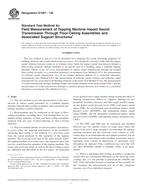 ASTM E1007-13b
ASTM E1007-13b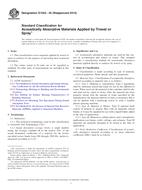 ASTM E1042-02(2014)..
ASTM E1042-02(2014)..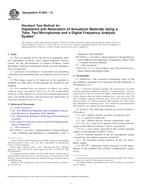 ASTM E1050-12
ASTM E1050-12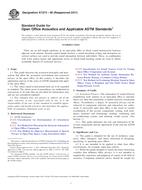 ASTM E1374-06(2011)..
ASTM E1374-06(2011)..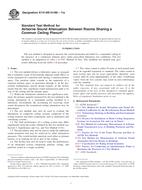 ASTM E1414/E1414M-11..
ASTM E1414/E1414M-11..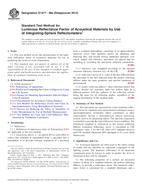 ASTM E1477-98a(2013)..
ASTM E1477-98a(2013)..
 Cookies
Cookies
